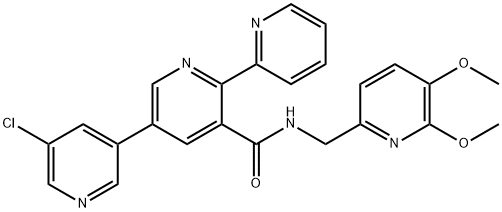in vivo
MK-1064 (30?mg/kg, oral administration) promotes sleep in rodents selectively through OX2R in Wild-type mice[2].
MK-1064 (30?mg/kg, oral administration, 5 days) reverses the struggle behavior induced by CNO pre-treatment in rats[3].
MK-1064 (1-5 mg/kg, intravenous injection/oral administration) shows moderate oral bioavailability and clearance in rat, dog, and rhesus monkey[1].
| Animal Model: | Wild-type and OX2R knockout mice[2] |
| Dosage: | 30 mg/kg |
| Administration: | Oral administration |
| Result: | Displayed active wake reduction accompanied by significant increases in SWS (slow-wave sleep) and REM (rapid eye movement) at time points up to 3.5?hours following treatment. |
| Animal Model: | Rat, dog, and rhesus monkey (Pharmacokinetics assay)[1] |
| Dosage: | 1, 2, 3, 5 mg/kg |
| Administration: | Oral administration (P.O.), intravenous injection (I.V.) |
| Result: | Pharmacokinetics profile of MK-1064.
| Species | Dose (mg/kg) | CL (mL/min/kg) | t1/2 (h) | Dose (mg/kg) | Cmax (μM) | F (%) | | Rat | 2 (I.V.) | 39 | 0.3 | 5 (P.O.) | 1.5 | 54 | |
| Dog | 1 (I.V.) | 16 | 1.0 | 3 (P.O.) | 1.0 | 48 | |
| Rhesus | 2 (I.V.) | 12 | 0.8 | 5 (P.O.) | 0.9 | 16 |
|
References
[1] Roecker AJ et al. Discovery of 5''-chloro-N-[(5,6-dimethoxypyridin-2-yl)methyl]-2,2':5',3''-terpyridine-3'-carboxamide (MK-1064): a selective orexin 2 receptor antagonist (2-SORA) for the treatment of insomnia. ChemMedChem. 2014 Feb;9(2):311-22. DOI:
10.1002/cmdc.201300447[2] Gotter AL et al. Orexin 2 Receptor Antagonism is Sufficient to Promote NREM and REM Sleep from Mouse to Man. Sci Rep. 2016 Jun 3;6:27147. DOI:
10.1038/srep27147[3] Laura A Grafe, et al. Orexin 2 receptor regulation of the hypothalamic-pituitary-adrenal (HPA) response to acute and repeated stress. Neuroscience. 2017 Apr 21;348:313-323. DOI:
10.1016/j.neuroscience.2017.02.038


